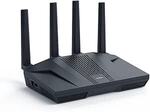This has been very popular previously and now it's back on sale for those after a high performance, open source router with plenty of features.
Like others from this brand it natively supports OpenWRT firmware, allowing full access to OpenWRT’s features and add-ons. It offers fast VPN integration with WireGuard and OpenVPN, along with built-in AdGuard Home for network wide ad blocking. The hardware is powerful and frequently receives firmware updates.
It features two 2.5G network ports with both being able to be used as WAN ports for a secondary connection, failover etc, 4 gigabit LAN ports, 4x4 WiFi 2.4GHz speeds up to 1148Mbps and 5GHz up to 4804Mbps, USB 3.0 port, 4 antennas and a multi plug charger.
- Redeem the coupon 7B8B2I7O at checkout
Specifications:
- 6x Ethernet ports (WAN/LAN)
- 1x USB 3.0 port
- 1x Reset button
- MediaTek Quad-core @ 2.0 GHz
- DDR4 1GB / eMMC 8GB
- IEEE 802.11a/b/g/n/ac/ax
- 1148Mbps (2.4GHz), 4804Mbps (5GHz)
- 2x 2.5G Ports (10/100/1000/2500Mbps)
- 4x 1G Ports (10/100/1000Mbps)
- Antennas 4x 2.4GHz + 5GHz two-in-one Wi-Fi Antennas
- LEDs 1x dual color LED indicator for Power and Internet
- Power Input DC5521, 12V/4A (5.5x2.1mm)
- Power Consumption <20W




 CamelCamelCamel
CamelCamelCamel

Depends, GL.iNet are great for advance users as the OS is build based on OpenWRT
It can be very useful for tech users to setup things like plugins, VPN etc. (eg. I have installed ShadowSocks client in GL iNet Beryl AX so to bypass firewall when travelling in China)
Asus AX86U Pro stock firmware already provide many features without the need to setup / install (flashing to Merlin firmware will even enhance further)
Asus routers support Mesh network with other Asus routers (even older ones such as AC68U)
so its a great use of old routers as a AiMesh nodes
My take:
If you only run 1 router without the need of Mesh, GL.iNet Flint 2 should provide very close performance to Asus AX86U Pro (might even outperform)
and Flint 2 is cheaper than AX86U Pro ($182.84 vs $299 Amazon price)
If you are advance user and would like to run third party plugins, Flint 2 is the way to go (especially you know some linux/bash and can SSH to the router)
If you are normal users and just want an easy-to-setup router, or you already have other Asus routers and would like to setup Mesh network
AX86U Pro is a solid choice